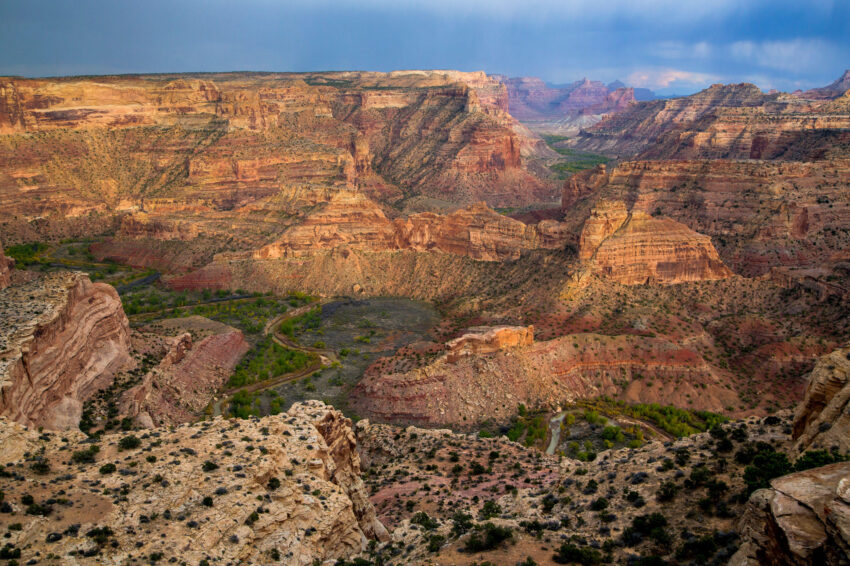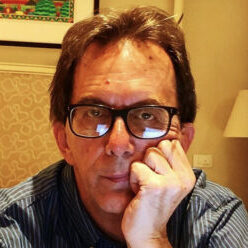For me, it took some longevity to learn to really appreciate geology. When I was in school, geology textbooks were pretty dull-looking. Someone gave me a rock collection with rocks glued to a posterboard, each one identified with the name of the type of rock: granite, pyrite, or sandstone. One of them was an amethyst, a purple gemstone, rough and uncut, as it looked when it was dug from the earth, shaped like a tiny crystalline rocket. I found them fascinating but that was about the extent of my appreciation of geology at that time.
Now, many years later, that’s all changed. Through the experiences of many tours to wild places, I have found that some of the most fascinating things I learned were from geologists.
I have come to see geology as a vibrant, mind-expanding field of inquiry. It’s one of the most fascinating ways to contemplate a spectacular landscape. At the Grand Canyon, for example, geologists can read the layers of earth going back 2 billion years. In the life of the mind, geology is a great trip. It can greatly enhance your perception and experience of a place you are visiting.
I’ve often had the privilege of traveling with naturalist guides who explain many things to me about the country that I would have had no idea of. These scientists working in tourism, who are trained in various fields, such as biology, chemistry, botany, evolutionary sciences or geology, apply those insights to places they study close-up day after day. They have amazing ways of amplifying your experience when you are traveling with them, absorbing the knowledge that pours off of them.
When I am on a trip to a place such as Antarctica, and the naturalist guides are giving presentations on board the ship, it’s often the geologists who come up with the most mind-blowing revelations. When they look at the landscapes, they are looking at a scale of time that is almost inconceivable to us ordinary humans, whose entire life span will fall inside of a single century. When geologists look at the formations of rocks and sediment in a landscape through the lens of their discipline, they can see back millions, sometimes billions of years.
There’s practically no way for the human, time-bound mind to conceive of such spans of time, except perhaps through geology itself. That’s what it does. It makes those numbers real, tangible. It helps you to understand your own place in the whole of things.

One of the most fascinating ways to get a sense of geological time is through the theory of continental drift. It was originally formulated by a German scientist named Alfred Wegener, who was trained in astronomy but taught meteorology and geophysics. After four trips to Greenland to study polar air circulation, he developed a theory that might begin to explain why the coasts of Africa and South America seem to fit together like pieces of a jigsaw puzzle.
They must have been joined together previously, he reasoned. So he developed a map of how all the continents could have fit together 252 million years ago. He called the supercontinent Pangea.
According to the theory, the continents are drifting at speeds of about an inch or two a year. An inch in a year is a distance that wouldn’t matter to an ant. But that’s where geological time comes into it. These infinitesimally slow movements only matter when you consider inconceivably long periods of time.
And so, as John Muir, the pioneer of the National Parks, said, “One learns that the world, though made, is yet being made; that this is still the morning of creation.”
I thought it was a huge revelation to find that the land masses had been joined together. But then later I realized that Pangea was only the beginning in that series of discoveries, only the most recent of the supercontinents. There were other groupings before, which have now been given names: Gondwana, Pannotia, Nuna, Rodinia, and Ur.
Those are the kinds of mind-spinning insights you can get from a geologist working as a guide on a tour. I recently discovered a new tour operator called GeoCultura that brings geology into the center of its travel experience, perhaps more than any other. It’s a tour operator that is actually a group of scientists based in London and the U.S.
Though GeoCultura does have a scientific focus, it does not focus on scientific matters to the exclusion of everything else. It views science as a part of culture and weaves it in with history and the arts. It blends Geo (earth) with Cultura (culture).
For example, a tour of the American Northeast travels from Philadelphia to western Massachusetts, retracing paths that were important in the American Revolutionary War. The itinerary includes points such as Independence Hall, Valley Forge, two Washington Crossings, the Great Falls at Paterson, the place where Aaron Burr killed Alexander Hamilton, and the route of Cornwallis’ pursuit of Washington up the Palisades. Besides scientists, the tour also brings on board respected authors and experts in Revolutionary War history. Art historians are there to discuss the effect of the landscape on artists such as William Hopper, Frederick Church, and Thomas Cole.

A GeoCultura tour of Southern England ties in the modern day with not only the Victorian and Georgian periods but with the Jurassic period. It includes Stonehenge, Bath, and Jurassic Coast sites such as Lulworth Cove and Chesil Beach.
GeoCultura’s trips take place in the U.K., at many North American destinations, Portugal, Spain and Greece.
The founders of the company are Rob Knipe, emeritus professor of structural geology at the University of Leeds, and a fellow of the Learned Society of Wales; Neil Harbury, a former senior lecturer at the University of London and founder of Nautilus, a geological training organization working with over 80 companies worldwide; and Mark Hammond, a visiting professor at Canterbury Christchurch University and a visiting Fellow at the University of Bath, as well as former chief executive of the Equality and Human Rights Commission..
GeoCultura LTD is launching 19 tour departures in 2023. Here’s a listing of selections that show how different these tours are from most others.
- NW Highlands of Scotland: Geology, Landscapes, History, and Controversies
- Going with the Flow in Southern California: Tales of Geology, Wine, and History
- The Jurassic Coast of England: Landscapes, Fossils, and Castles
- Reefs, Turtles and Pirates: A Dip into the Geology, Ecology, and History of the Bahamas
- A Western USA Adventure: Exploring the Geology, Archaeology, and Western Lore of Utah and Wyoming
- Energy of the Future: Exploring the GeoEnergy Revolution in Cornwall, England
- London, Stonehenge, Bath, and the Jurassic Coast: A geo-culture tour of Southern England
- A Geocultural Tour of Aragon: Geology, History, and Gastronomy in the Spanish Pyrenees
- ·Rambling, Rafting, Riding, and Rifting: Exploring the Rio Grande Rift of Colorado and New Mexico
- Wisconsin Rocks and Art: Glaciers, Baraboo, Frank Lloyd Wright, and the American Players Theatre
- The Rockies and the Badlands: Geology and dinosaurs in Canada
- Mountains and Deserts: The Landscapes, Earth History and Heritage of Southern Arizona
- The Dawn of the Dinosaurs and its Legacy in War, Art, and Science in the Northeastern US
- The Collision of Tectonics and Culture: The Influence of Salt on Landscapes, History and People in the Catalan Pyrenees
- Prairies to Pacific – An Epic Journey through the Geology, Landscapes, and History of Western Canada
- Stone, Water and Quakes: A Geo-historical Tour of Old Town Lisbon and the Arrábida National Park
- The Fascinating Landforms and Fossil Treasures of England’s Jurassic Coast
- A Desert Adventure: Southeastern Utah Landscapes and Cultures
- England’s Lake District: Landscapes, Literature, and Geology
For more information, see www.geoculturaworld.com, or call +44 2081 451011.

David Cogswell is a freelance writer working remotely, from wherever he is at the moment. Born at the dead center of the United States during the last century, he has been incessantly moving and exploring for decades. His articles have appeared in the Chicago Tribune, the Los Angeles Times, Fortune, Fox News, Luxury Travel Magazine, Travel Weekly, Travel Market Report, Travel Agent Magazine, TravelPulse.com, Quirkycruise.com, and other publications. He is the author of four books and a contributor to several others. He was last seen somewhere in the Northeast US.



